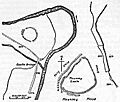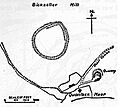Scheduled monuments in West Somerset (H–Z) facts for kids
West Somerset was a special area in the English county of Somerset. It used to have its own local government. But on April 1, 2019, it joined with another area called Taunton Deane. Together, they formed a new, bigger area called Somerset West and Taunton.
Contents
Ancient Wonders
West Somerset is full of amazing old sites that tell us about people who lived here long, long ago. These places are protected because they are so important to history.
Hillforts: Ancient Forts on Hills
Imagine living in a time when you needed strong defenses! Hillforts were like ancient forts, usually built during the Iron Age. People used the natural shape of hills to create strong walls and ditches around their homes.
- Grabbist Hillfort: This large oval hillfort near Dunster is over 270 meters long! It has a big bank and a deep ditch around it. The northern side was extra strong.
- Mounsey Castle: Near Dulverton, this hillfort is shaped like a triangle. It has old stone walls and looks over the River Barle.
- Oldberry Castle: Also near Dulverton, this Iron Age hillfort is shaped like an oval. It has a bank and ditch that are still visible today.
- Trendle Ring: In Bicknoller, this ancient earthwork covers a large area. It has a single rampart (a defensive bank) and a ditch.
Mysterious Stone Circles and Standing Stones
Long before written history, people built mysterious stone structures.
- Porlock Stone Circle: On Porlock Common, this stone circle once had 21 stones. Today, 14 stones remain, some still standing tall.
- Withypool Stone Circle: On Withypool Hill, this circle has 25 standing stones and is 36 meters wide. It's a truly ancient place!
- Culbone Stone: Near Oare, this standing stone is about one meter tall. It has a special cross carved into it, which might be from the 7th to 9th century. It's a very old and protected monument.
- Halscombe Stone Setting: In Exmoor, you can find two rows of standing stones. Some are still upright, while others have fallen over time.
- The Whit Stones: On Porlock Common, these are two standing stones, each nearly a meter high, standing about 7 meters apart.
Barrows and Cairns: Ancient Burial Mounds
Many hills in West Somerset hide ancient burial mounds. These were built in the Neolithic and Bronze Age periods.
- Huish Champflower Barrow: This "bowl barrow" is 21 meters wide. It's a round mound where people were buried long ago.
- Pixie's Mound: In Stogursey, this large cairn (a mound of stones) is 27 meters wide. Explorers have found remains of bodies and flint tools inside!
- Selworthy Beacon Cairn: This ancient burial mound was later used as a fire beacon in the 16th century. It's a mix of earth, stone, and history!
- Wambarrows on Winsford Hill: This is a whole cemetery of round barrows! There are at least five mounds, showing where many ancient people were buried.
Historic Bridges: Crossing Rivers Through Time
Rivers needed to be crossed, and people built amazing bridges that are still standing today.
- Horner Packhorse Bridge: This old stone bridge crosses Horner Water in Luccombe. It was used by packhorses carrying goods.
- Landacre Bridge: In Withypool, this beautiful stone bridge crosses the River Barle. It has five arches and was first mentioned in records in 1610.
- Malmsmead Bridge: Near Oare, this two-arch stone bridge carries a small road over Badgworthy Water. It dates back to the 17th century.
- Tarr Steps: This famous "clapper bridge" crosses the River Barle in Exmoor National Park. It's made of huge stone slabs, some weighing up to two tons! It might be as old as 1000 BC.
Castles and Fortified Homes
Castles are always exciting, and West Somerset has some great ones!
- Dunster Castle: This amazing castle sits on a steep hill called the Tor. It's been a fortified site since Anglo-Saxon times! After the Normans arrived, they built a timber castle, and later a stone one. The Luttrell family lived here for centuries. Today, it's a popular tourist attraction run by the National Trust.
- Stogursey Castle: Built in the 11th or 12th century, this was a "motte-and-bailey" castle with a large mound and two walled areas, surrounded by a moat. Even though it was ordered to be destroyed twice, it survived for a long time!
Holy Wells and Village Crosses
These sites show the importance of water and faith in the past.
- Holy Well at St Pancras Chapel: In Old Cleeve, this stone-lined well was a special, sacred place in the Middle Ages.
- St Leonard's Well: Near Dunster, this 16th-century stone well house covers a medieval holy well. It might have supplied water to the nearby priory.
- Stringston Churchyard Cross: This cross from the 14th century is still standing in the churchyard in Stringston. It's a beautiful piece of history.
- Wayside Cross in Williton: You can find the remains of a medieval cross on the main street in Doniford, near Williton.
Industrial History and War Defenses
Not all old sites are from ancient times. Some show us how people worked and defended themselves more recently.
- Ironstone Mine Ventilation Flue: In Luxborough, this tall chimney was part of the old Bearland Wood Iron Mine. It helped pull air and gases out of the mine.
- The Incline, West Somerset Mineral Railway: Near Old Cleeve, this was a very steep railway track built in 1861. It was used to bring iron ore down the hill using ropes.
- World War II Pillboxes: You can find concrete "pillboxes" in places like Clatworthy and Old Cleeve. These small, strong buildings were built in 1940 to help defend against attacks during World War II.
Images for kids








































